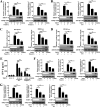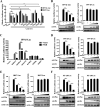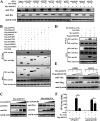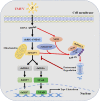Tembusu Virus Nonstructural Protein 2B Antagonizes Type I Interferon Production by Targeting MAVS for Degradation
- PMID: 35867574
- PMCID: PMC9327690
- DOI: 10.1128/jvi.00816-22
Tembusu Virus Nonstructural Protein 2B Antagonizes Type I Interferon Production by Targeting MAVS for Degradation
Abstract
Tembusu virus (TMUV) is a newly emerged avian flavivirus that has caused severe egg-drop syndrome and fatal encephalitis in domestic ducks. It has spread widely throughout the main duck-producing areas in Asia, resulting in substantial economic losses to the duck industry. Previous studies have reported that TMUV has evolved several strategies to counteract the duck's innate immune responses to successfully establish infection in its host cells. However, the mechanisms underlying this phenomenon have not been elucidated. Here, we discovered that TMUV-encoded NS2B is a negative regulator of poly(I:C)-induced duck interferon-β (IFN-β) expression. Mechanistically, TMUV NS2B was found to interact specifically with the mitochondrial antiviral-signaling protein (duMAVS). Consequently, duMAVS was degraded through the K48-linked ubiquitination and proteasomal pathway, leading to the interruption of the RIG-I-like receptor (RLR) signaling. Further analyses also identified K321, K354, K398, and K411 as crucial residues for NS2B-mediated ubiquitination and degradation of duMAVS. Additionally, we demonstrated that NS2B functions by recruiting the E3 ubiquitin ligase duck membrane-associated RING-CH-type finger 5 (duMARCH5) to modify duMAVS via polyubiquitination, blocking the duMAVS-mediated innate immune response and promoting TMUV replication. Taken together, our findings revealed a novel mechanism by which TMUV evades the duck's antiviral innate immune responses. IMPORTANCE Tembusu virus (TMUV), an emerging pathogenic flavivirus, has spread to most duck farming areas in Asia since 2010, causing significant economic losses to the duck industry. Recently, TMUV has expanded its host range and may pose a potential threat to mammals, including humans. Understanding the interaction between TMUV and its host is essential for the development of effective vaccines and therapeutics. Here, we show that NS2B encoded by TMUV inhibits IFN production by interacting with duck MAVS (duMAVS) to mediate ubiquitination and proteasomal degradation. Further studies suggest that the E3 ubiquitin ligase duck membrane-associated RING-CH-type finger 5 (duMARCH5) is recruited by NS2B to mediate proteasomal degradation of duMAVS. As a result, the innate immune response triggered by the RIG-I-like receptor (RLR) is disrupted, facilitating viral replication. Overall, our results reveal a novel mechanism by which TMUV evades host innate immunity and provide new therapeutic strategies to prevent TMUV infection.
Keywords: MAVS; NS2B; Tembusu virus; degradation; interferon.
Conflict of interest statement
The authors declare no conflict of interest.
Figures








Similar articles
-
MARCH6 suppresses Tembusu virus replication by targeting viral NS5 protein for TOLLIP-mediated selective autophagic degradation.J Virol. 2025 Jul 22;99(7):e0073525. doi: 10.1128/jvi.00735-25. Epub 2025 Jun 13. J Virol. 2025. PMID: 40511919 Free PMC article.
-
Binding of Duck Tembusu Virus Nonstructural Protein 2A to Duck STING Disrupts Induction of Its Signal Transduction Cascade To Inhibit Beta Interferon Induction.J Virol. 2020 Apr 16;94(9):e01850-19. doi: 10.1128/JVI.01850-19. Print 2020 Apr 16. J Virol. 2020. PMID: 32075929 Free PMC article.
-
Duck TRIM35 Promotes Tembusu Virus Replication by Interfering with RIG-I-Mediated Antiviral Signaling in Duck Embryo Fibroblasts.Microbiol Spectr. 2022 Dec 21;10(6):e0385822. doi: 10.1128/spectrum.03858-22. Epub 2022 Nov 29. Microbiol Spectr. 2022. PMID: 36445078 Free PMC article.
-
An updated review of avian-origin Tembusu virus: a newly emerging avian Flavivirus.J Gen Virol. 2017 Oct;98(10):2413-2420. doi: 10.1099/jgv.0.000908. Epub 2017 Sep 6. J Gen Virol. 2017. PMID: 28874226 Review.
-
Innate immune responses to duck Tembusu virus infection.Vet Res. 2020 Jul 8;51(1):87. doi: 10.1186/s13567-020-00814-9. Vet Res. 2020. PMID: 32641107 Free PMC article. Review.
Cited by
-
Advancements in Research on Duck Tembusu Virus Infections.Viruses. 2024 May 20;16(5):811. doi: 10.3390/v16050811. Viruses. 2024. PMID: 38793692 Free PMC article. Review.
-
Mitochondrial Antiviral Signaling Protein Activation by Retinoic Acid-Inducible Gene I Agonist Triggers Potent Antiviral Defense in Umbilical Cord Mesenchymal Stromal Cells Without Compromising Mitochondrial Function.Int J Mol Sci. 2025 May 14;26(10):4686. doi: 10.3390/ijms26104686. Int J Mol Sci. 2025. PMID: 40429828 Free PMC article.
-
TRIM14 restricts tembusu virus infection through degrading viral NS1 protein and activating type I interferon signaling.PLoS Pathog. 2025 May 28;21(5):e1013200. doi: 10.1371/journal.ppat.1013200. eCollection 2025 May. PLoS Pathog. 2025. PMID: 40435148 Free PMC article.
-
MARCH6 suppresses Tembusu virus replication by targeting viral NS5 protein for TOLLIP-mediated selective autophagic degradation.J Virol. 2025 Jul 22;99(7):e0073525. doi: 10.1128/jvi.00735-25. Epub 2025 Jun 13. J Virol. 2025. PMID: 40511919 Free PMC article.
-
Dengue Virus 2 NS2B Targets MAVS and IKKε to Evade the Antiviral Innate Immune Response.J Microbiol Biotechnol. 2023 May 28;33(5):600-606. doi: 10.4014/jmb.2210.10006. Epub 2023 Feb 15. J Microbiol Biotechnol. 2023. PMID: 36788451 Free PMC article.
References
Publication types
MeSH terms
Substances
Supplementary concepts
LinkOut - more resources
Full Text Sources
Research Materials
Miscellaneous

